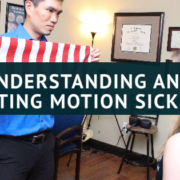Understanding and Treating Persistent Motion Sickness

Patients with persistent motion sickness represent a subset of patients commonly associated with dizziness and imbalance. While many patients with motion sickness have it in relationship with a condition like migraine, vestibular migraine, or BPPV, there are many patients who just struggle with it on it’s own without a complaint of dizziness.
Motion sickness isn’t an illness where you feel a false sense of motion like vertigo. Motion sickness is a problem that different types of motion or perception of motion will cause you to feel nauseated and sick. The difference between these concepts makes a big difference in how you will need to be treated.
Historically it has been a challenge to diagnose and treat these patients because traditional tests of dizziness and imbalance are going to be negative. Without a strong understanding of motion sickness, it becomes difficult to provide treatments or therapies that have enduring effectiveness, and all you are left with are anti-nausea medications.
Patients with motion sickness can feel ill along a wide variety and intensities of motion. The most common form of motion sickness occurs in people who have difficulty riding in boats or cars. A large portion of the population has experienced motion sickness when riding in a rocking boat or attempting to read in a car.
In it’s more severe forms, patients can feel sick with small amounts of head movement, or when exposed to a busy visual background. The feeling of sickness can cause progressive nausea that can eventually lead to vomiting.
What Drive Motion Sickness
As you can tell, being so sensitive to motion that small head movements or visual stimuli can induce vomiting can feel quite limiting and debilitating for a patient. I personally hate the feeling of nausea more than I hate pain, and it’s common for these patients to avoid social events and gatherings so they can feel safe in the comfort of home.
What happens in the body to generate this terrible feeling?
Most of our understanding of motion sickness stems from our knowledge of nausea and vomiting. Nausea can be driven directly by sensation from the vestibular organ or the gut. Neurological signals from the inner ear and the gut travel to the lower brainstem called the medulla where there are specific neurons dedicated to vomiting.

When these neurons are activated, they activate pathways that increase the production of saliva, take deeper breaths, and initiate contractions of the esophagus and diaphragm. That feeling is also triggering the sympathetic nervous system causing blood flow changes that can lead your hands to get cold and you start to sweat.
Remember that this is a pathway for vomiting. Many patients aren’t going to go through this entire process, but the brain regions associated with this process probably contribute to the levels of nausea people have with motion sensitivity.

Based on this knowledge, we have sense that patients with persistent motion sickness and nausea may have problems in these regions which serve as targets for treatment or rehabilitation:
- Vestibular dysfunction – especially the otolithic organs
- Gut dysregulation
- Brain driven sensory sensitivity
Sensory Mismatch and Motion Sickness
The exact mechanisms for how motion sickness triggers the above neurological pathways is currently unknown. The most common theory that I’ve found to have practical treatment implications is called the Sensory Mismatch or Sensory Conflict theory.
The theory suggests that you have 3 systems in your body that help you detect if you are in motion. These are the:
- Visual System
- Vestibular System
- Proprioceptive System
Under most circumstances, your brain takes information from these senses and compares it to the brain’s expectation for motion.
Let’s say that you’re going for a run. Your eyes detect movement of the background while you’re running, your muscles detect motion of your joints, your ears detect the bobbing motion of your head, and your brain knows what it is supposed to feel like to go for a run. When these senses all agree and your brain recognizes how this is supposed to feel , then your brain doesn’t have to resolve any conflict and motion feels perfectly fine.
In patients with motion sickness, the information coming from these senses might be weighted different by the brain. What does that mean? It means that your brain may be more sensitive and prioritize the information that comes from your eyes more than the information that comes from your vestibular system or vice versa.
Now your brain has a problem. Your visual system might be saying that you’re moving a lot while your vestibular and proprioceptive systems aren’t perceiving any motion (Kind of like driving in a car right?). Your senses are conflicting, so your brain has to make the final call.
If your brain doesn’t have good information for how this is supposed to feel, then the sensory mismatch isn’t resolved and the conflict leads to you activating the pathways that drive nausea. The most common expression of this is called vestibular-visual mismatch, and is likely the driving force in nausea and motion sickness in vestibular migraine.

How does this help us treat patients with motion sickness?
By understanding the influence that these sensory systems play in motion sickness, we can use a careful examination of these systems to determine where and how to provide different therapies.
In my office, we test eye movements, ocular misalignment, balance, and optokinetic responses to assess the way the brain responds to different sensory conditions.

Once we have an idea of how a patient’s senses might be betraying them, then we can move into a treatment strategy to fix it. First we would try to re-weight their sensory system, then we slowly expose the patient to the offending stimuli.
What does this look like as an example?
The majority of patients we have seen with motion sickness have a high level of visual dependency meaning that they rely too strongly on visual information to maintain balance.
If you have high visual dependency then your brain places too much emphasis on detecting visual motion. If this is the case, you can be watching a movie with a busy action sequence and your brain is going to think that you are moving despite the fact that your vestibular and proprioceptive systems say that you are sitting still.
So if we know that the patient is way too visually dependent, then we would have the patients perform exercises to increase their ability to rely on vestibular and proprioceptive senses. That means we might do a lot of their exercises or therapies with their eyes closed initially and gradually progress them to doing exercises with eyes open. As they can tolerate these motions better, then we might slowly start to expose them to the busy visual environments that would normally induce dizziness.
It can be complicated and nerve racking to confront motion sickness because patients with this problem have spent so much time designing their life to avoid these nauseating activities.
But at the end of the day if we are really going to give people their lives back, then we need to have the courage to confront the things that have kept us in the prison of our perceived broken bodies.


